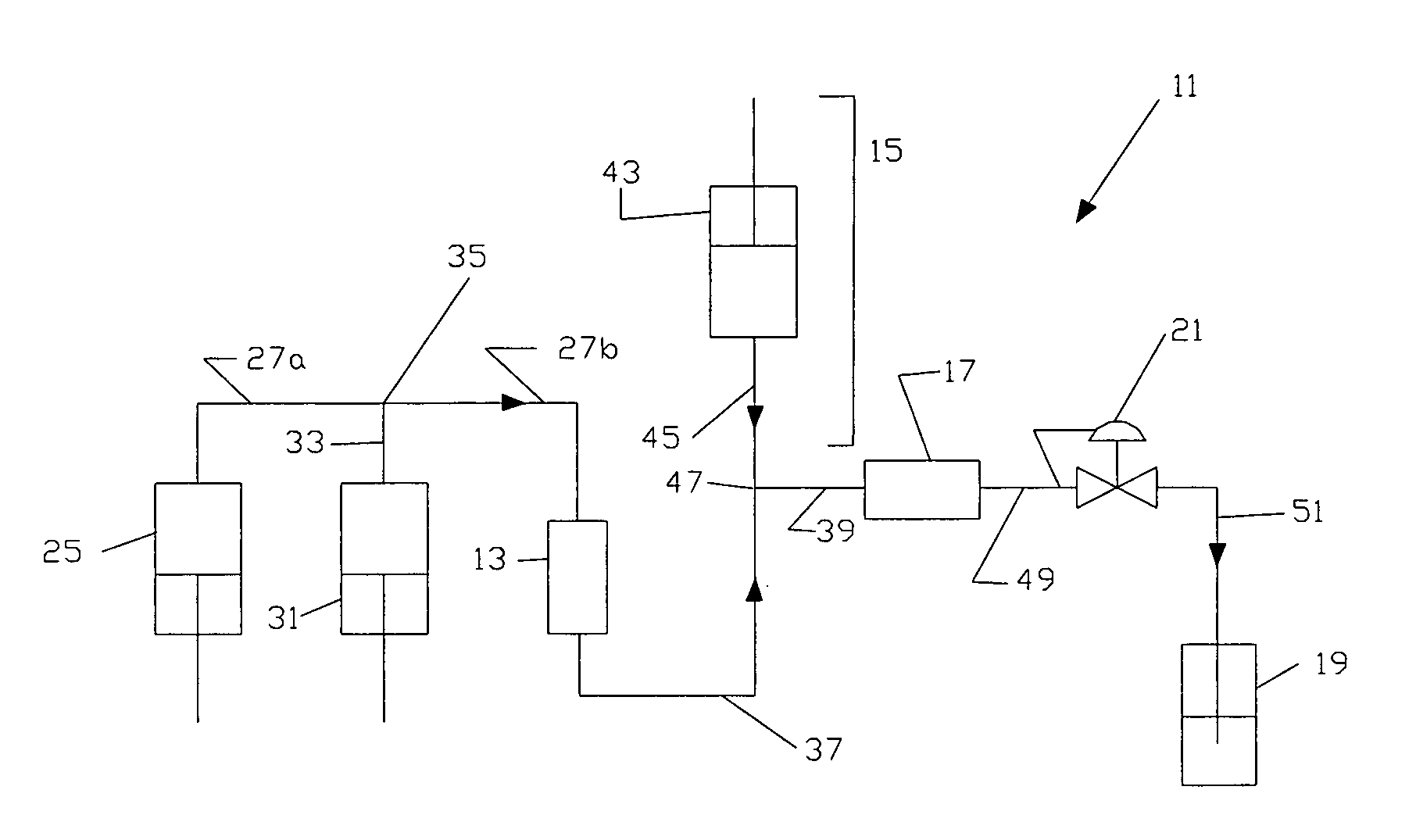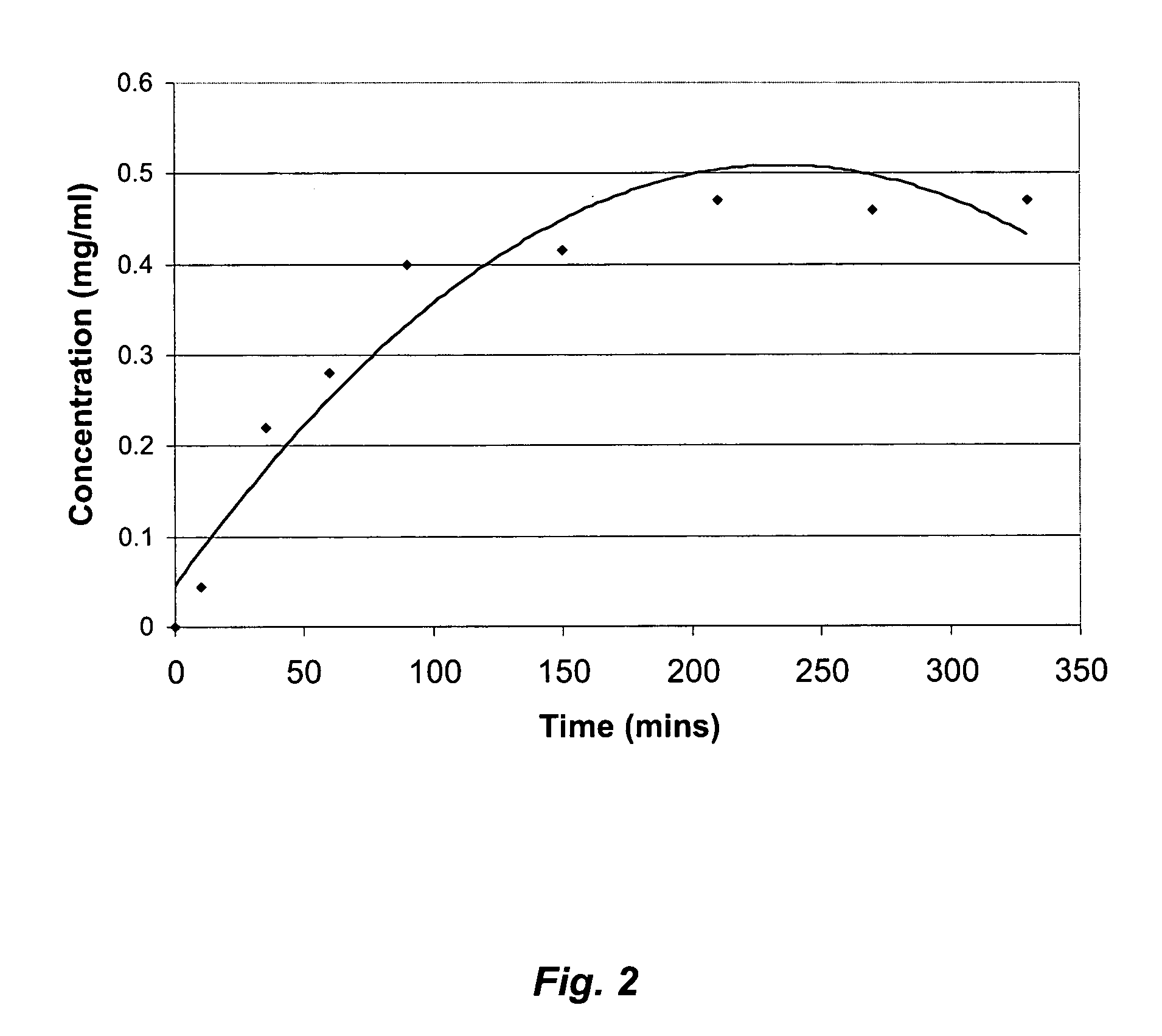Polymer microspheres/nanospheres and encapsulating therapeutic proteins therein
a technology of nanospheres and polymer microspheres, which is applied in the direction of microcapsules, capsule delivery, manufacturing tools, etc., can solve the problems of reducing the concentration of most therapeutic proteins, and affecting the effect of encapsulation
- Summary
- Abstract
- Description
- Claims
- Application Information
AI Technical Summary
Benefits of technology
Problems solved by technology
Method used
Image
Examples
example 1
SCCNC Polymer Microspheres / Nanospheres Formed with Near-Critical Propane
[0055]Polymer microspheres / nanospheres were formed with 50:50 PLGA obtained from Sigma Chemicals (St. Louis, Mo.) in the SCCNC polymer sphere apparatus running in the continuous mode. The polymer microspheres / nanospheres were formed by injecting the SCCNC polymer solution into distilled water. The resulting product was observed under a light microscope, and the particle sizes were measured in a Coulter 4MD sub-micron particle size analyzer. The volume of distilled water used in PMF-03a was about half of that used in PMF-01 resulting in a more concentrated microsphere solution and a different particle size distribution. Some of these results are presented in Table 3.
[0056]
TABLE 3SCCNC Polymer Microspheres / NanospheresFormed with 50:50 PLGA at 40° C.FlowRateSmallMediumLargePressure(mL / SizeSizeSizeRun No.SCCNC(psig)min)(nm) / %(nm) / %(nm) / %PMF-01C3H82,0001.099 (26%)336 (74%)PMF-02aC3H84,0001.0120 (34%) 2,120(66%)PMF-02...
example 2
Protein Antigencity in Polymer Microspheres Formed by Different SCCNC
[0057]Experiments were performed to encapsulate tetanus toxoid (TT) and diphtheria toxoid (DT) vaccine antigens in 50:50 PLGA polymer microspheres formed by SCCNC carbon dioxide and propane. In these tests, DT and TT were each separately treated with supercritical carbon dioxide with 10% (v / v) cosolvent ethanol, and near-critical propane in the presence of PLGA. The pressure and temperature were around 3,000 psig and 30–35° C. respectively. The protein and antigenicity activities were performed by micro BCA assay and a sandwich-type capture ELISA [Gupta, R. K., Siber, G. R., Alonso, M. J. and Langer, R., in Modern Approaches To New Vaccines Including Prevention of AIDS. Ed. by Ginsberg, H. S., Brown, F., Chanock, R. M. and Lerner, R. A. Cold Spring Harbor Laboratory, Press, 1993] assay. The results of this study are summarized in Table 4.
[0058]
TABLE 4Protein Content and Antigencity of Tetanus Toxoid and Diphtheria ...
example 3
Protein (Insulin) Encapsulation by SCCNC Polymer Microspheres / Nanospheres
[0060]Experiments were conducted to encapsulate insulin in polymer microspheres / nanospheres utilizing supercritical carbon dioxide. Insulin, which has an isoelectric point of 3.65, is stable at acid pHs. In these experiments, a feed solution of 0.1 mg / mL insulin in 90% ethanol: 10% water was utilized. The supercritical carbon dioxide was pumped at a rate of 1 mL / min, the cosolvent pump at 0.1 mL / min, and the insulin solution at 0.5 mL / min. The resultant mixture was injected into 8 mL of 1% PVA solution for 30 minutes. The results of these experiments are summarized in Table 5.
[0061]
TABLE 5Polymer Microspheres / Nanospheres Formed with Medisorb Polymers andInsulin in SCCNC Carbon Dioxide / Cosolvent at 3,000 psig and 50° C.SmallRunSizeMediumLargeNo.PolymerSCCNC(nm)Size (nm)Size (nm) / %MS-09DL2ACO2 / 750(22%)5,250(77%)ethanolMS-10DL2MCO2 / 634(100%)ethanolMS-11DL3ACO2 / 300(49%)10,000(51%)ethanolMS-12DL2ACO2 / 326(100%)aceton...
PUM
| Property | Measurement | Unit |
|---|---|---|
| diameter | aaaaa | aaaaa |
| diameter | aaaaa | aaaaa |
| diameter | aaaaa | aaaaa |
Abstract
Description
Claims
Application Information
 Login to View More
Login to View More - R&D
- Intellectual Property
- Life Sciences
- Materials
- Tech Scout
- Unparalleled Data Quality
- Higher Quality Content
- 60% Fewer Hallucinations
Browse by: Latest US Patents, China's latest patents, Technical Efficacy Thesaurus, Application Domain, Technology Topic, Popular Technical Reports.
© 2025 PatSnap. All rights reserved.Legal|Privacy policy|Modern Slavery Act Transparency Statement|Sitemap|About US| Contact US: help@patsnap.com



